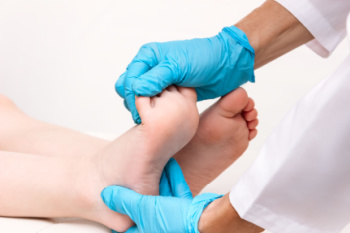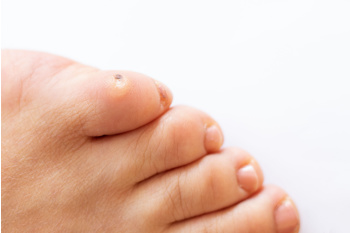Items filtered by date: August 2024
Foot Problems in Children

Children commonly experience a variety of foot problems as they grow. Sprains are frequent, often resulting from sports or rough play, causing pain, swelling, and difficulty in walking. Prompt treatment with rest and elevation is essential to prevent further injury. In-toeing and out-toeing, where a child's feet point inward or outward while walking, are common developmental issues. Most cases resolve as the child grows, but persistent problems may require evaluation by a podiatrist. Athlete's foot, a fungal infection, causes itching, redness, and peeling, usually between the toes. It is prevalent in children who wear tight, sweaty shoes. Fungal nail infections, another concern, lead to thickened, discolored nails that may become brittle. Maintaining proper foot hygiene, wearing appropriately sized shoes, and addressing any foot pain early are key to preventing complications. If your child has any foot or ankle issues, it is suggested that you schedule an appointment with a podiatrist for a proper diagnosis and treatment.
Making sure that your children maintain good foot health is very important as they grow. If you have any questions, contact Donald Manger, DPM of Associated Podiatric Physicians, PA. Our doctor can provide the care you need to keep you pain-free and on your feet.
Keeping Children's Feet Healthy
Having healthy feet during childhood can help prevent medical problems later in life, namely in the back and legs. As children grow, their feet require different types of care. Here are some things to consider...
Although babies do not walk yet, it is still very important to take care of their feet.
Avoid putting tight shoes or socks on his or her feet.
Allow the baby to stretch and kick his or her feet to feel comfortable.
As a toddler, kids are now on the move and begin to develop differently. At this age, toddlers are getting a feel for walking, so don’t be alarmed if your toddler is unsteady or ‘walks funny’.
As your child gets older, it is important to teach them how to take care of their feet.
Show them proper hygiene to prevent infections such as fungus.
Be watchful for any pain or injury.
Have all injuries checked by a doctor as soon as possible.
Comfortable, protective shoes should always be worn, especially at play.
If you have any questions please feel free to contact our office located in Hamilton Township, NJ . We offer the newest diagnostic and treatment technologies for all your foot and ankle needs.
Tips for Finding Shoes That Fit Properly

Choosing shoes that fit well is essential for foot health, as wearing poorly fitting shoes can lead to discomfort and may even cause foot problems. To find the perfect fit, it is best to measure your feet while in a shoe store, ensuring you account for length, width, and arch length. Foot size and shape can change over time due to aging, so relying on old measurements is not recommended. Shopping for shoes later in the day when your feet are naturally swollen helps ensure a better fit. Standing during measurement provides a more accurate size, as weight distribution affects foot shape. It is also important to prioritize fit over size labels, as these can vary between brands. Always try on shoes with the socks or hosiery you intend to wear with them, ensuring enough room for movement in the toe box and a slight space at the heel to prevent blisters. Shoes can help with foot problems, but they can also cause problems if they do not fit well. If you are seeking tips for buyng shoes that fit properly to avoid possible uncomfortable foot conditions, it is suggested that you schedule an appointment with a podiatrist.
Finding a properly-fitting shoe is important in reducing injuries and preventing foot problems. For more information about treatment, contact Donald Manger, DPM from Associated Podiatric Physicians, PA. Our doctor will treat your foot and ankle needs.
Proper Shoe Fitting
A common concern when it comes to foot health, having properly fitted shoes can help prevent injuries to the foot. Out feet affect our posture and gait, which in turn affects the biomechanics and overall bodily structure. With 33 joints, 26 bones, and over 100 ligaments, the potential for serious injury is much greater than one realizes. Although the feet cease growth in adulthood, they still change shape as they mature. Here are some factors to consider when it comes to investing in proper fitting shoes:
- Be sure the shoes fit correctly right away
- Ensure the ball of your foot fits comfortably in the widest portion of the shoes
- Even though they may look fashionable, improper fitting shoes can either create adverse conditions or exacerbate existing ones you may already have
- Walk along a carpeted surface to ensure the shoes comfortably fit during normal activity
Keeping in mind how shoes fit the biomechanics of your body, properly-fitting shoes are vitally important. Fortunately, it is not difficult to acquire footwear that fits correctly. Be sure to wear shoes that support the overall structure of your body. Do your feet a favor and invest in several pairs of well-fitted shoes today.
If you have any questions please feel free to contact our office located in Hamilton Township, NJ . We offer the newest diagnostic and treatment technologies for all your foot and ankle needs.
Symptoms, Causes and Risk Factors for Corns

Corns form in the feet when skin is subjected to continuous pressure or friction, commonly on the toes and soles. At first, the skin thickens, creating a callus. But persistent pressure can transform this into a painful corn, which can be recognized by a raised, yellowish-beige surface and a defined hard core. Corns between toes are often softer and whitish due to moisture. Causes include wearing tight shoes, foot deformities, and joint diseases, which heighten pressure on specific areas. Risk increases with age and dry skin. Recognizing a corn is straightforward, but differentiation from similar issues like warts may require a podiatrist’s expertise. Effective treatment involves eliminating the source of the pressure, wearing shoes that fit properly, and possibly using pads or insoles. Removing a corn yourself is discouraged, as unsafe conditions can prompt an infection. If you have painful corns on the feet or toes, it is suggested that you schedule an appointment with a podiatrist for an exam, diagnosis, and treatment.
Corns can make walking very painful and should be treated immediately. If you have questions regarding your feet and ankles, contact Donald Manger, DPM of Associated Podiatric Physicians, PA. Our doctor will treat your foot and ankle needs.
Corns: What Are They? And How Do You Get Rid of Them?
Corns are thickened areas on the skin that can become painful. They are caused by excessive pressure and friction on the skin. Corns press into the deeper layers of the skin and are usually round in shape.
Ways to Prevent Corns
There are many ways to get rid of painful corns such as:
- Wearing properly fitting shoes that have been measured by a professional
- Wearing shoes that are not sharply pointed or have high heels
- Wearing only shoes that offer support
Treating Corns
Although most corns slowly disappear when the friction or pressure stops, this isn’t always the case. Consult with your podiatrist to determine the best treatment option for your case of corns.
If you have any questions please feel free to contact our office located in Hamilton Township, NJ . We offer the newest diagnostic and treatment technologies for all your foot and ankle needs.
Gout Pain Can Be Managed
Gout Pain Can Be Managed
Gout Pain Can Be Managed
Understanding Laser Therapy for Fungal Nails

Laser therapy for toenail fungus is a non-invasive treatment aimed at eliminating fungal infections in toenails or fingernails. This procedure involves using concentrated light energy to target and destroy the fungus that resides beneath the nail bed without causing damage to surrounding tissues. The laser penetrates the nail plate to reach the infection, effectively killing the fungus and promoting healthy nail growth over time. Laser therapy is considered safe and painless, but typically requires multiple sessions spaced several weeks apart to achieve optimal results. It is often preferred for its minimal side effects compared to oral medications or topical treatments. However, like any treatment, results can vary, and some individuals may require additional sessions to completely eradicate the fungal infection. If you have developed stubborn toenail fungus, and are considering having this type of therapy, it is suggested that you consult a podiatrist who can determine if this is the right treatment for you.
Laser treatment can be an effective way to get rid of toenail fungus. If you have any questions about laser treatment, consult with Donald Manger, DPM from Associated Podiatric Physicians, PA. Our doctor will assess your condition and provide you with quality treatment for fungal nails.
What Are Toenail Fungal Infections?
Onychomycosis, or fungal infection of the nail, is a relatively common and non-serious condition. Around 10 percent of U.S. citizens are afflicted with fungal nails. Common forms of fungus that infect the nail include dermatophytes, yeasts, and molds.
Symptoms of Toenail Fungal Infections Include:
- Nail thickening
- Brittleness of the nail
- Discoloration of the nail
Diagnosis for Fungal Nails
Fungal infections are diagnosed by fungal culture and microscopy. This will rule out any other conditions such as nail trauma, psoriasis, lichen planus, and onychogryphosis.
What Is Laser Treatment?
Laser treatment is a non-invasive, safe, quick, and painless procedure that uses the heat from a laser to kill fungus in the nail. Each infected nail is targeted with a laser for several minutes. The treatment is usually utilized several different times over a select period. During this time, a podiatrist will keep an eye on the infection.
If you have any questions, please feel free to contact our office located in Hamilton Township, NJ . We offer the newest diagnostic and treatment technologies for all your foot care needs.

